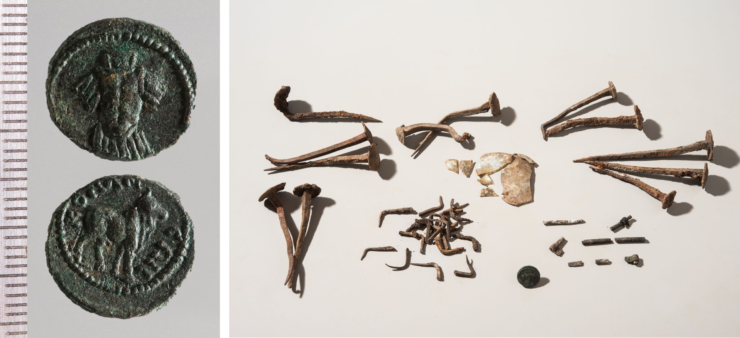A 2,000-year-old tomb unearthed in Turkey was strewn with “dead nails” and sealed with bricks and cement, most likely to “protect the living from the dead.”
A cremation grave sealed with not just two dozen bricks but also a layer of plaster and peppered with purposefully bent nails, people may have feared the “restless dead” in ancient Rome, a new study indicates.
The strange tomb, discovered at the site of Sagalassos in southwest Turkey and dating to A.D. 100-150, contained 24 bricks that had been painstakingly laid on the still-smoldering pyre, 41 bent and twisted nails, and a layer of lime plaster on top. According to the study, which was released on February 21 in the journal Antiquity, the subject, an adult male, was burned and buried in the same location, which was rare in Roman times.
“The tomb was closed off with not one, not two, but three different ways that can be understood as attempts to shield the living from the dead — or the other way around,” study first author Johan Claeys, an archaeologist at Catholic University Leuven (KU Leuven), said. Although cremation in situ, plaster or tile covers, and the rare bent nail are all procedures that are familiar from Roman-era cemeteries, the trio of them has never been observed previously and suggests a dread of the “restless dead,” he claimed.
From the fifth century B.C. until the thirteenth century A.D., the archaeological site of Sagalassos was inhabited, and it contains several Roman-era buildings, including a theater and a bath complex. Once it was abandoned, the city was immediately covered in vegetation, which preserved it.
The “non-normative cremation” was one of the burials that were unearthed and investigated as part of the Sagalassos Archaeological Research Project. Roman cremations typically consisted of a funeral pyre, the gathering of the cremains, placement in an urn, and tomb in a cemetery or mausoleum. Yet, the researchers were able to determine from the anatomical placement of the surviving bones that the Sagalassos cremation was carried out on the spot.
The juxtaposition between the burial items and the tomb’s closing seemed even more strange. According to the news of Live Science, the researchers found typical burial relics, including ceramic and glass dishes, coins, pieces of a woven basket, and food scraps. “It seems clear that the deceased was buried with all appropriate aplomb,” Claeys said. “It seems likely that was the suitable way of parting with a loved one at the time.”
The bent nails, which are frequently found in Western European cemeteries dating to the first to second centuries A.D., are a common finding, according to Marco Milella, a research fellow at the Institute of Forensic Medicine at the University of Bern in Switzerland who was not involved in this study.
Claeys believes that the individual buried in this peculiar cremation burial was most likely interred by his family in a ceremony that required days to plan and execute. A sort of magic, or an action meant to have a certain impact due to a supernatural link, is the best way to understand the set of beliefs that led people in Sagalassos to bury this guy in an unusual fashion. While the researchers were unable to detect any signs of sickness or damage on the bones, it is likely that his peculiar burial was performed to prevent an unnatural or strange death. Sadly, Claeys stated that “it cannot be proven with certainty whether or not any family members were buried nearby” despite the fact that the “magic cremation” coincides in time with other burials since DNA is typically destroyed by high temperatures in ancient cremations.
“Regardless of whether the cause of [the man’s] death was traumatic, mysterious or potentially the result of a contagious illness or punishment,” the researchers concluded in the study, it appears to have left “the living fearful of the deceased’s return.”
